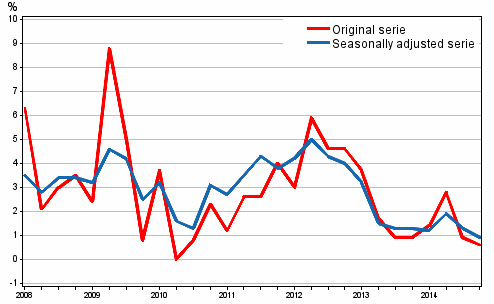Published: 11 March 2015
Cost of an hour worked went up by 0.6 per cent in October to December
Private sector labour costs rose by 0.6 per cent in October to December 2014 when compared with the respective period of the year before. Seasonally adjusted labour costs rose by 0.9 per cent in October to December 2014. Labour costs without one-off pay items, such as performance-based bonuses, went up by 0.6 per cent compared to the corresponding period one year ago. Over the same period, the index of wage and salary earnings for the private sector went up by 1.4 per cent.
Year-on-year change in labour costs in the private sector from the respective quarter of previous year

In the central government sector, labour costs went down by 0.7 per cent in October to December 2014 when compared with the respective period of the year before. Labour costs without one-off pay items went down by 0.9 per cent over the same period. Seasonally adjusted labour costs went up by 0.1 per cent. In the local government sector, labour costs rose by 0.2 per cent in October to December 2014 when compared with the respective period of the year before. Costs without one-off pay items remained unchanged year-on-year.
The fourth quarter of 2014 had one working day more than in 2013. The variation in the number of working days in the same quarter between different years has an effect on labour costs, because the cost is calculated per hours worked.
Compared to the year before, the average increase of labour costs during 2014 was 1.5 per cent in the private sector, 2.1 per cent in the central government sector and 1.6 per cent in the local government sector. Seasonally adjusted average increase of 2014 compared to the year before was 1.3 per cent in the private sector and 1.9 per cent in the central government sector. The increase in social insurance contributions raised the cost of an hour worked in all sectors in 2014. Without social security contributions, the cost of an hour worked grew by 1.3 per cent in the private sector, by 1.3 per cent in the central government sector, and by 1.4 per cent in the local government sector.
Annual changes in labour costs according to Standard Industrial Classification 2008, 4th quarter 2014
| Code | Industry | Labour Costs, Year-on-year change |
||
| Labour costs | Labour costs, excluding one-off items |
Labour Costs, seasonally adjusted | ||
| B-S | Total | 0,6 | 0,6 | 0,9 |
| B-E | Industry | -0,1 | -0,2 | 0,3 |
| F | Construction | 0,7 | -0,2 | 0,8 |
| G-N | Business service sector | 0,7 | 0,8 | 0,7 |
| J-R | State sector | -0,7 | -0,9 | 0,1 |
| D-S | Local government sector | 0,2 | 0,0 | .. |
Calculated by industry, the cost of an hour worked went down by 0.1 per cent in all manufacturing in October to December 2014 when compared with the respective period of the year before. In the chemical industry, the cost of an hour worked grew by 3.0 per cent and in the metal industry it decreased by 1.2 per cent. Growth in the construction industry amounted to 0.7 per cent. The cost of an hour worked in business service activities went up by 0.7 per cent. In services, the cost of an hour worked increased most in information and communication, by 3.5 per cent, and the biggest decline was seen in wholesale and retail trade, by 1.2 per cent.
The seasonally adjusted cost of an hour worked in all manufacturing went up by 0.3 per cent in October to December 2014 compared with the corresponding period last year. In the chemical industry, the cost of an hour worked went up by 1.1 per cent and in the metal industry it decreased by 1.5 per cent in the October to December period of 2014 from the same period of the previous year. In construction, the seasonally adjusted cost of an hour worked grew by 0.8 per cent. The respective rise in business service activities was 0.7 per cent. In wholesale and retail trade, the cost of an hour worked went down by 0.4 per cent, while in information and communication activities the costs grew by 0.2 per cent.
The labour cost index measures the change in labour costs calculated per hour worked. The change in average labour costs is affected by contractual pay increase of earnings and the wage drift, one-off pay components, social insurance tariffs, changes in the number of worked hours and structural change in labour force.
Source: Wages, Salaries and Labour Costs, Statistics Finland
Inquiries: Pekka Haapala 029 551 3460, Hanna Jokimäki 029 551 3667, Petri Ruohonen 029 551 3465, tvkindeksi@stat.fi
Director in charge: Hannele Orjala
Publication in pdf-format (288.8 kB)
- Tables
-
Tables in databases
Pick the data you need into tables, view the data as graphs, or download the data for your use.
Appendix tables
- Appendix table 1. Labour costs, Labour Cost Index 2008=100 (11.3.2015)
- Appendix table 2. Labour costs, percentage changes, Labour Cost Index 2008=100 (11.3.2015)
- Appendix table 3. Labour costs, excluding one-off items, Labour Cost Index 2008=100 (11.3.2015)
- Appendix table 4. Labour costs, excluding one-off items, percentage changes, Labour Cost Index 2008=100 (11.3.2015)
- Appendix table 5. Seasonally adjusted labour costs, Labour Cost Index 2008=100 (11.3.2015)
- Appendix table 6. Seasonally adjusted labour costs, percentage changes, Labour Cost Index 2008=100 (11.3.2015)
- Appendix table 7. Standard Industrial Classification 2008 (11.3.2015)
- Revisions in these statistics
-
- Revisions in these statistics (11.3.2015)
Updated 11.03.2015
Official Statistics of Finland (OSF):
Labour cost index [e-publication].
ISSN=1798-3746. 4th quarter 2014. Helsinki: Statistics Finland [referred: 20.4.2025].
Access method: http://stat.fi/til/tvki/2014/04/tvki_2014_04_2015-03-11_tie_001_en.html

